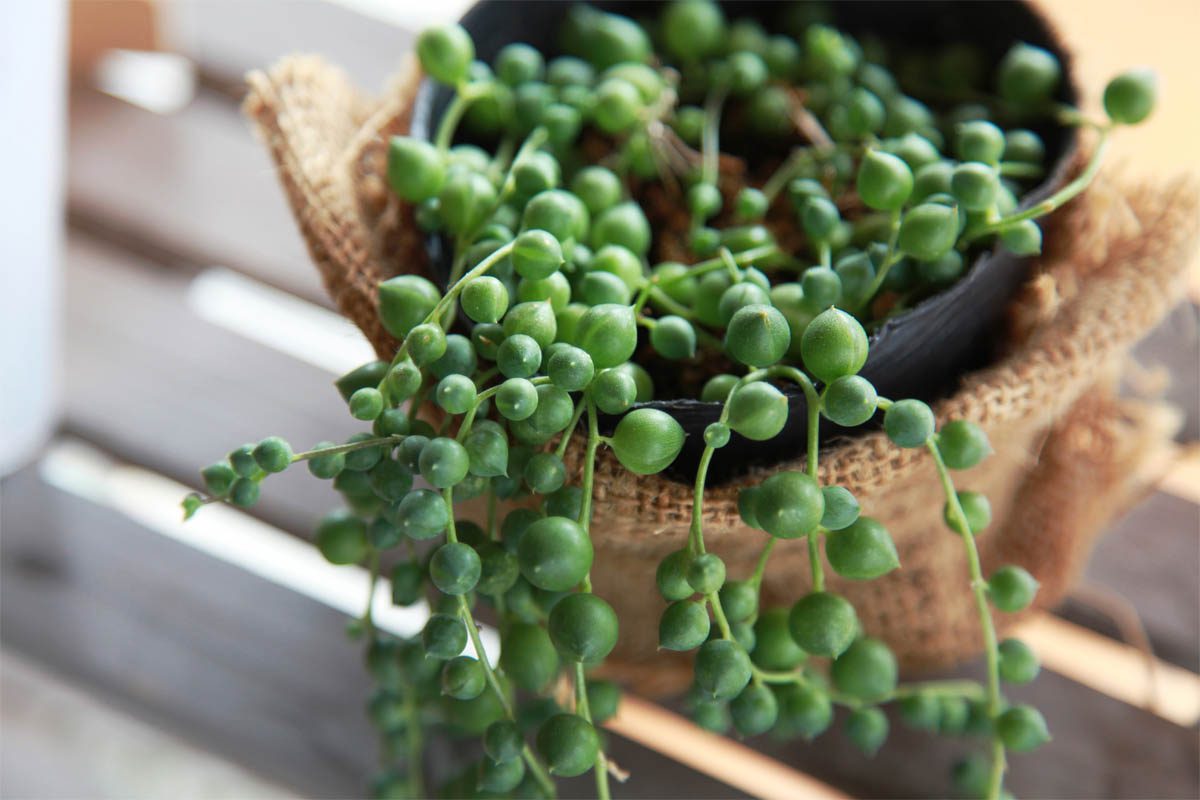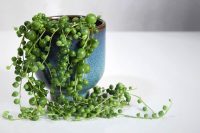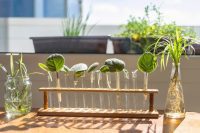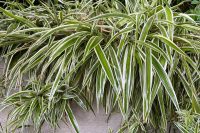String of pearls (Curio rowleyanus) is a hardy succulent native to South Africa which has seen a huge surge in popularity in the past few years. Its long stems contain pearl-shaped leaves that cascade down pots when they are long enough.
There are three ways to propagate string of pearls, direct, water, or layering. Each is as simple as the next. The key to propagation is to choose healthy parent stock.
Equipment
- Sharp pair of scissors
- Pot
- Succulent potting mix
- Hormone powder (optional)
- Twig or pencil
- Floral pins (optional)
- String of pearls plant cutting(s)
How to propagate string of pearls
The best time to propagate string of pearls is during spring or summer, as temperatures are warmer and the days are longer. Alternatively, start off cuttings inside the house or a greenhouse.
I prefer to propagate into the final pot the plant will live in, as re-potting string of pearls can be a challenge due to the number of daughter plants in each pot. If you do repot, do so before the stems have grown too long.
It will take three to four weeks for your string of pearls to develop a root system in potting mix and water in warm weather.
What part of string of pearls do I need to propagate?
In order to successfully propagate string of pearls, you will need a stem, with at least one node on it. You cannot propagate string of pearls from a pearl.
Direct propagation in soil
Step 1
Cut several 10 cm (4 inches) stems from the mother plant and carefully remove the top 2.5 cm (1 inch) of pearls. Cut just above a leaf node (where the leaf meets the stem), this is where the roots will grow from. Try to cut at an angle to increase the surface area.
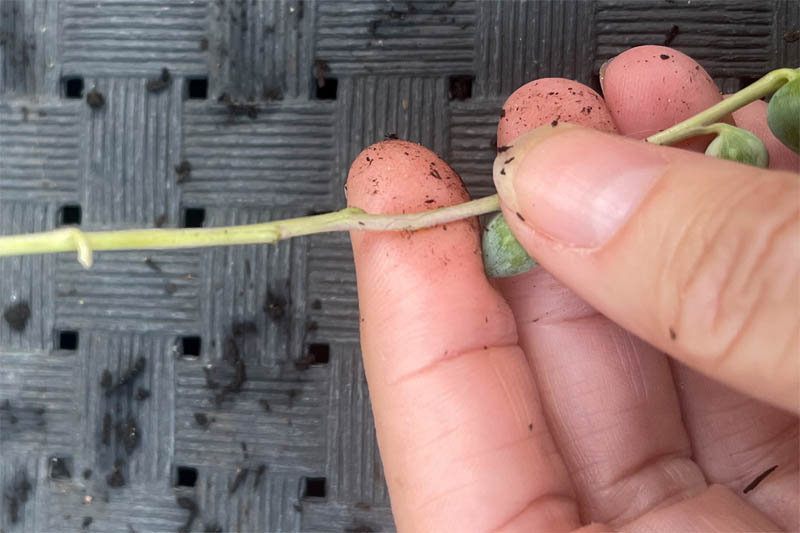
Step 2
Using your pencil, scissors, or twig, gently make a hole in the potting mix and carefully place the stripped portion of the stem into the soil. You can dip the end in hormone powder before placing it in the soil. There must be at least one node beneath the soil for the cutting to develop roots.
Note: One study found a hormone mix containing both naphthalene acetic acid (NAA) and Indolebutyric acid (IBA) had a greater strike rate on Malay apple stem cuttings¹. Transfer a small amount of rooting powder to a clean container, which will be used to treat the cuttings, to prevent cross-contamination of future cuttings.
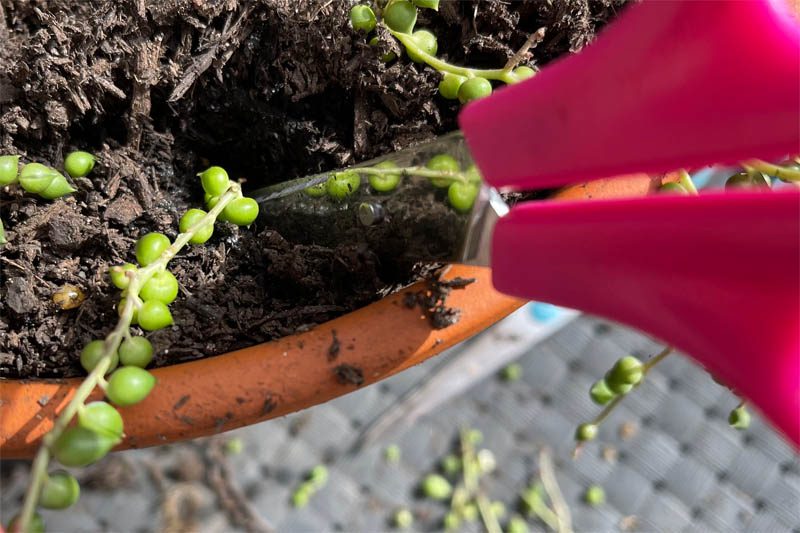
Step 3
Gently close up the hole, press down firmly to secure the cutting in the pot and remove any air pockets and mist the soil, it should be damp but not saturated. It will be necessary to place multiple stems into one pot to produce the mass cascading effect. The number of cuttings will depend on the circumference of the pot.
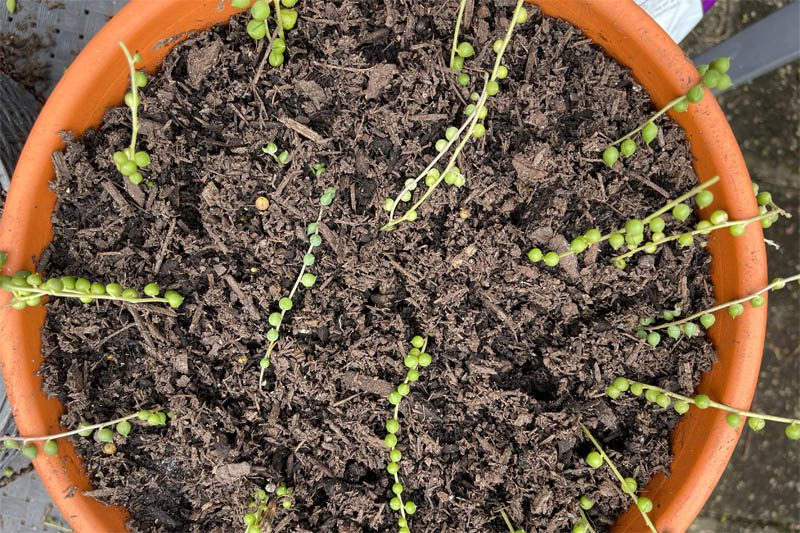
Step 4
Place the pot in a bright location, but out of direct sunlight. Mist spray when the top layer of soil dries out.
Layering propagation
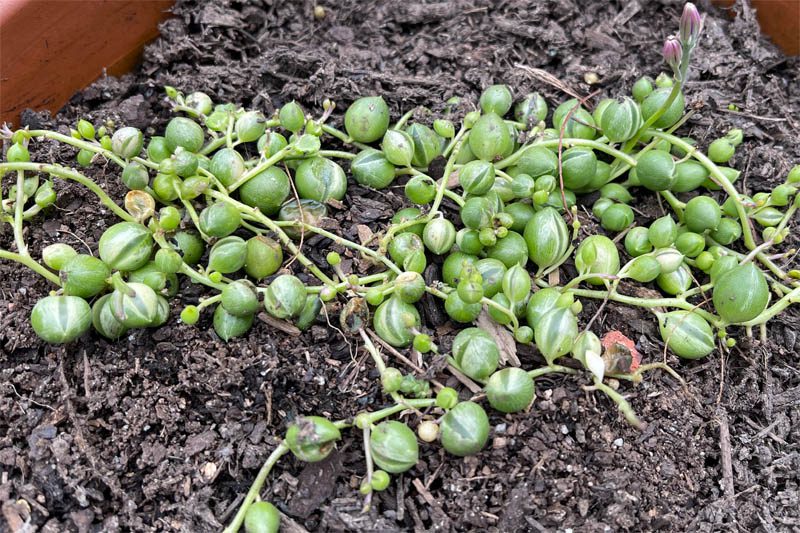
Layering is similar to direct, however, instead of placing one end of the stem into the pot, and leaving the terminal end to cascade down, the entire stem is layered on top of the soil. Each node along the stem will produce new roots. I find this produces a more robust plant than direct sowing. The plant will eventually fill the entire pot, before cascading down the sides.
Step 1
Cut several 10 cm (4 inches) stems from the mother plant and carefully remove the top 2.5 cm (1 inch) of pearls. Make the cut just above a leaf node (where the leaf meets the stem), this is where the roots will grow from.
Step 2
Using your pencil, scissors, or twig, gently make a hole in the potting mix and carefully place the stripped portion of the stem into the soil. You can dip the end in hormone powder before placing it in the soil. There must be at least one node beneath the soil for the cutting to develop roots.
Step 3
Lay the remainder of the stem directly on top of the soil and gently push down so that the stem is in contact with the soil. Secure with floral pins, or sprinkle a small amount of potting mix over the cuttings, and gently brush away any excess with a pastry brush to expose the pearls (leaves).
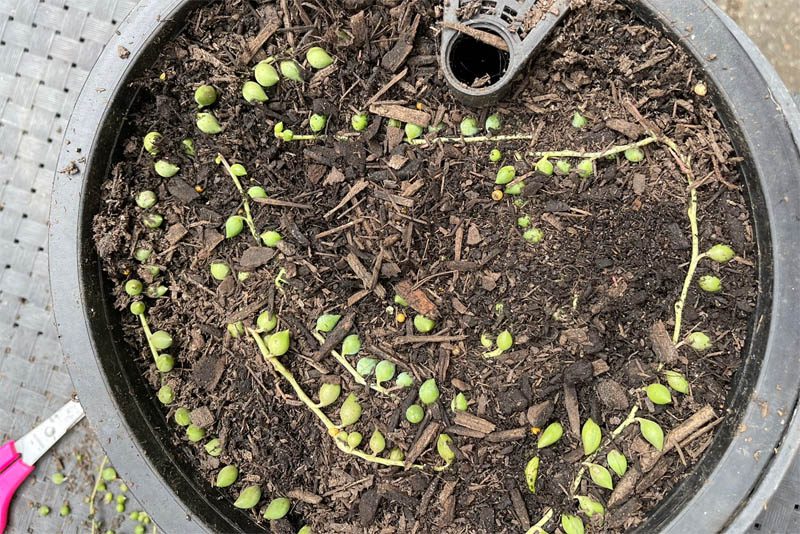
Water propagation
Step 1
Cut several 10 cm (4 inches) stems from the mother plant and carefully remove the top 2.5 cm (1 inch) of pearls. Cut just above a leaf node (where the leaf meets the stem), this is where the roots will grow from.
Step 2
Place the cut stem into the water, leaving the leaves (pearls) out of the water. The water should be changed every 3 days.
Step 3
Once the roots have developed, transfer the cutting into a pot with cacti mix.
How long does it take a string of pearls cutting to develop roots?
It takes between 2 – 4 weeks for string of pearls to develop roots. During this time, keep the cuttings moist, but not soggy. The ideal position is bright indirect light until the cuttings are established.
Propagating other curio species
If you like string of pearls, you may also try propagating related species, which includes the following:
- Curio radicans – String of bananas, String of beans
- Curio peregrinus – String of dolphins
- Curio herreianus – String of watermelons, String of beads, String of raindrops
- Curio citriformis – String of tears
REFERENCES
- Yusnita, Y., Jamaludin, J., Agustiansyah, A., & Hapsoro, D. (n.d.). A combination of IBA and NAA resulted in better rooting and shoot sprouting than single auxin on Malay apple [syzygium malaccense (L.) Merr. & perry] stem cuttings. AGRIVITA, Journal of Agricultural Science. Retrieved October 15, 2022, from https://agrivita.ub.ac.id/index.php/agrivita/article/view/1210
Julia is a writer and landscape consultant from Wollongong with a love of horticulture. She had been an avid gardener for over 30 years, collects rare variegated plants and is a home orchardist. Julia is passionate about learning and sharing her knowledge of plant propagation and plant toxicology. Whether it’s giving advice on landscape projects or sharing tips on growing, Julia enjoys helping people make their gardens flourish.
